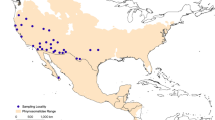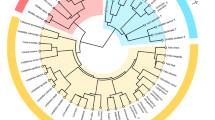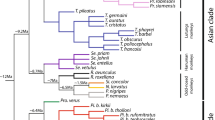Abstract
Evolutionary allometry describes size and shape differences across taxa matched for developmental stage (e.g., adulthood). Allometric studies can identify subtle differences among species, and therefore help researchers interested in small-bodied, cryptic species such as tarsiers. Recent taxonomic revision has emphasized size differences among three possible tarsier genera inhabiting different island regions: Sulawesi (genus: Tarsius), Borneo (genus: Cephalopachus), and the Philippines (genus: Carlito). We examined seven craniodental measures of 102 museum specimens of adult tarsiers representing these three regions. We found that the allometric patterns within groups do not predict the observable differences among groups. Crania of the largest-bodied genus, Cephalopachus, are characterized by relatively short skulls and small orbits, with wider palates and molars than predicted by allometric increase from the smaller-bodied Tarsius. Overall, we found tarsier skulls stay the same shape as they increase in size. This may reflect shared developmental and biomechanical adaptations across tarsier groups filling an extreme leaping, faunivorous niche with hypertrophied orbits and subtle dietary differences in prey selection. These shared adaptations of tarsiers may severely limit the range of body sizes in tarsiers and impose further constraints on cranial shape. Despite their deep divergence times in the Miocene, living tarsier groups are united by a common craniodental form across a limited size range. Adaptations to extreme niches might result in a hyperconservatism of the cranium. Future primate allometric studies should explore cranial variation in other taxa to determine how adaptations to specific niches affect the size and shape of the cranium.






Similar content being viewed by others
References
Anemone, R. L., & Nachman, B. A. (2003). Morphometrics, functional anatomy, and the biomechanics of locomotion among tarsiers. In P. C. Wright, E. L. Simons, & S. Gursky (Eds.), Tarsiers: Past, present and future (pp. 97–120). New Brunswick: Rutgers University Press.
Beard, K. C. (1998). A new genus of Tarsiidae (Mammalia: Primates) from the Middle Eocene of Shanxi Province, China, with notes on the historical biogeography of tarsiers. Bulletin of Carnegie Museum of Natural History, 34, 260–277.
Beard, K. C., Qi, T., Dawson, M. R., Wang, B., & Li, C. K. (1994). A diverse new primate fauna from middle Eocene fissure-fillings in southeaster China. Nature, 368, 604–609.
Bolker, B., Phillips, P. C. (n.d.). Common principal components/back-projections analysis. cpcbp package version 0.3.3.
Brandon-Jones, D. (1998). Pre-glacial Bornean primate impoverishment and Wallace’s line. In R. Hall & J. D. Holloway (Eds.), Biogeography and geological evolution of SE Asia (pp. 393–404). Leiden: Backhuys.
Brown, R. M., Weghorst, J. A., Olson, K. V., Duya, M. R. M., Barley, A. J., et al (2014). Conservation genetics of the Philippine tarsier: Cryptic genetic variation restructures conservation priorities for an island archipelago primate. PLoS One, 9(8), e104340.
Burnaby, T. P. (1966). Growth-invariant discrimination functions and generalized distances. Biometrics, 22, 96–110.
Chaimanee, Y., Chavasseau, O., Beard, K. C., Kyaw, A. A., Soe, A. N., et al. (2012). Late Middle Eocene primates from the Myanmar and the initial anthropoid colonization of Africa. Proceedings of the National Academy of Sciences of the USA, 109, 10293–10297.
Chaimanee, Y., Lebrun, R., Yamee, C., Jaeger, J. J. (2011). A new Middle Miocene tarsier from Thailand and the reconstruction of its orbital morphology using a geometric-morphometric method. Proceedings of the Royal Society of London B: Biological Sciences, rspb20102062.
Cheverud, J. M. (1982). Relationships among ontogenetic, static, and evolutionary allometry. American Journal of Physical Anthropology, 59, 139–149.
Cheverud, J. M., & Marroig, G. (2007). Comparing covariance matrices: Random skewers method compared to the common principal components model. Genetics and Molecular Biology, 30(2), 461–469.
Crompton, R. H., & Andau, P. M. (1987). Ranging, activity rhythms, and sociality in free-ranging Tarsius bancanus: A preliminary report. International Journal of Primatology, 8(1), 43–71.
Dagosto, M., Gebo, D. L., & Dolino, C. N. (2003). The natural history of the Philippine tarsier (Tarsius syrichta). In P. C. Wright, E. L. Simons, & S. Gursky (Eds.), Tarsiers: Past, present and future (pp. 237–259). New Brunswick: Rutgers University Press.
Driller, C., Merker, S., Perwitasari-Farajallah, D., Sinaga, W., Anggraeni, N., & Zischler, H. (2015). Stop and go-waves of tarsier dispersal mirror the genesis of Sulawesi island. PLoS One, 10(11), e0141212.
Evans, A. R., & Sanson, G. D. (1998). The effect of tooth shape on the breakdown of insects. Journal of Zoology London, 246, 391–400.
Fleagle, J. G. (1985). Size and adaptations in primates. In W. L. Jungers (Ed.), Size and scaling in primate biology (pp. 1–19). New York: Plenum Press.
Flury, B. (1988). Common principal components and related multivariate models. New York: John Wiley & Sons.
Ford, S. M. (1980). Callitrichids as phyletic dwarfs, and the place of the Callitrichidae in Platyrrhini. Primates, 21, 31–43.
Gelman, A., & Weakliem, D. (2009). Of beauty, sex and power: Too little attention has been paid to the statistical challenges in estimating small effects. American Scientist, 97, 310–316.
Gingerich, P. D., Smith, B. H., & Rosenberg, K. (1982). Allometric scaling in the dentition of primates and prediction of body weight from tooth size in fossils. American Journal of Physical Anthropology, 58, 81–100.
Gould, S. J. (1975). On the scaling of tooth size in mammals. American Zoologist, 15, 353–362.
Groves, C. (1998). Systematics of tarsiers and lorises. Primates, 39, 13–27.
Groves, C., & Shekelle, M. (2010). The genera and species of Tarsiidae. International Journal of Primatology, 31, 1071–1082.
Gursky, S. (2007). Tarsiiformes. In C. Campbell, A. Fuentes, K. MacKinnon, M. Panger, & S. K. Bearder (Eds.), Primates in perspective (pp. 73–85). Oxford: Oxford University Press.
Hadfield, J. D. (2010). MCMC methods for multi-response generalized linear mixed models: The MCMCglmm R package. Journal of Statistical Software, 33(2), 1–22.
Hennig, C. (2015). Package ‘fpc’.
Howland, H. C., Merola, S., & Basarab, J. B. (2004). The allometry and scaling of the size of vertebrate eyes. Vision Research, 44(17), 2043–2065.
Jablonski, N. G. (2003). The evolution of the Tarsiid niche. In P. C. Wright, E. L. Simons, & S. Gursky (Eds.), Tarsiers: Past, present and future (pp. 35–49). New Brunswick: Rutgers University Press.
Jablonski, N. G., & Crompton, R. H. (1994). Feeding behavior, mastication, and tooth wear in the Western tarsier (Tarsius bancanus). International Journal of Primatology, 5(1), 29–59.
Jungers, W. L., Falsetti, A. B., & Wall, C. E. (1995). Shape, relative size, and size-adjustments in morphometrics. Yearbook of Physical Anthropology, 38, 137–161.
Klingenberg, C. P. (1996). Multivariate allometry. In L. F. Marcus, M. Corti, A. Loy, G. J. P. Naylor, & D. E. Slice (Eds.), Advances in morphometrics (pp. 23–49). New York: Springer-Verlag.
Klingenberg, C. P. (2016). Size, shape, and form: Concepts of allometry in geometric morphometrics. Development Genes and Evolution, 226, 113–137.
Leigh, S. R., Shah, N. F., & Buchanan, L. S. (2003). Ontogeny and phylogeny in papionin primates. Journal of Human Evolution, 45, 285–316.
Marroig, G., & Cheverud, J. M. (2009). Size and shape in callimico and marmoset skulls: allometry and heterochrony in the morphological evolution of small anthropoids. In S. M. Ford, L. M. Porter, & L. C. Davis (Eds.), The marmoset/callimico radiation (pp. 331–354). New York: Springer Science+Business Media.
McCoy, M. W., Bolker, B. M., Osenberg, C. W., Miner, B. G., & Vonesh, J. R. (2006). Size correction: Comparing morphological traits among populations and environments. Oecologia, 148, 547–554.
Merker, S., Driller, C., Perwitasari-Farajallah, D., Pamungkas, J., & Zischler, H. (2009). Elucidating geological and biological processes underlying the diversification of Sulawesi tarsiers. Proceedings of the National Academy of Sciences of the USA, 106, 8459–8464.
Merker, S., Thomas, S., Volker, E., Perwitasari-Farajallah, D., Feldmeyer, B., et al (2014). Control region length dynamics potentially drives amino acid evolution in tarsier mitochondrial genomes. Journal of Molecular Evolution, 79(1–2), 40–51.
Mitteroecker, P., Gunz, P., Windhager, S., & Schaefer, K. (2013). A brief review of shape, form, and allometry in geometric morphometrics, with applications to human facial morphology. Hystrix, 24, 59–66.
Musser, G. G., & Dagosto, M. (1987). The identity of Tarsius pumilus, a pygmy species endemic to the montane mossy forests of central Sulawesi. American Museum Novitates, 2867, 1–53.
Niemitz, C. (1984). The biology of tarsiers. New York: Gustav Fischer Verlag.
Nietsch, A. (1993). Beitrage zur Biologie von Tarsius spectrum in Sulawesis-Zur morphometric, Entwicklung sowie zum Verhalten unter halbfreien und unter Freilandbedingungne. PhD thesis, Free University of Berlin.
Ovaskainen, O., Cano, J. M., & Merilä, J. (2008). A Bayesian framework for comparative quantitative genetics. Proceedings of the Royal Society of London B: Biological Sciences, 275, 669–678.
Paradis, E. (2010). pegas: An R package for population genetics with an integrated-modular approach. Bioinformatics, 26, 419–420.
Phillips, P. C., & Arnold, S. J. (1999). Hierarchical comparison of genetics variance-covariance matrices. I. Using the Flury hierarchy. Evolution, 53(5), 1506–1515.
R Development Core Team (2013). R: A language and environment for statistical computing. Vienna: R Foundation for Statistical Computing.
Roff, D. A., Prokkola, J. M., Krams, I., & Rantala, M. J. (2012). There is more than one way to skin a G matrix. Journal of Evolutionary Biology, 25(6), 1113–1126.
Rosenberger, A. L. (2010). The skull of Tarsius: Functional morphology, eyeballs, and the nonpursuit of predatory lifestyle. International Journal of Primatology, 31, 1031–1054.
Rosenberger, A. L., & Preuschoft, H. (2012). Evolutionary morphology, cranial biomechanics and the origins of tarsiers and anthropoids. Palaeobiodiversity and Palaeoenvironments, 92(4), 507–525.
Rosenberger, A. L., Smith, T. D., DeLeon, V. B., Burrows, A. M., Schenck, R., & Halenar, L. B. (2016). Eye size and set in small-bodied fossil primates: A three-dimensional method. The Anatomical Record, 299, 1671–1689.
Rossie, J. B., Xijun, N., & Beard, K. C. (2006). Cranial remains of an Eocene tarsier. Proceedings of the National Academy of Sciences of the USA, 103(12), 4381–4385.
Rychlik, L., Ramalhinho, G., & Polly, P. D. (2006). Response to environmental factors and competition: Skull, mandible and tooth shapes in Polish water shrews (Neomys, Soricidae, Mammalia). Journal of Zoological Systematics and Evolutionary Research, 44(4), 339–351.
Schluter, D. (1996). Adaptive radiation along genetic lines of least resistance. Evolution, 50(5), 1766–1774.
Sebastiao, H., & Marroig, G. (2013). Size and shape in cranial evolution of 2 marsupial genera: Didelphis and Philander (Didelphimorphia, Didelphidae). Journal of Mammalogy, 94(6), 1424–1437.
Shekelle, M., Groves, C., Gursky, S., Neri-Arboleda, I., & Nietsch, A. (2008). A method for multivariate analysis and classification of tarsier tail tufts. In M. Shekelle, I. Maryanto, C. P. Groves, H. Schulze & H. Fitch-Snyder (Eds.), Primates of the oriental night (pp. 71–84). Cibinong: Indonesian Institute of Sciences.
Shekelle, M., Meier, R., Wahyu, W. I., & Ting, N. (2010). Molecular phylogenetics and chronometrics of Tarsiidae based on 12S mtDNA haplotypes: Evidence for Miocene origins of crown tarsiers and numerous species within the Sulawesian Clade. International Journal of Primatology, 31, 1083–1106.
Simons, E. L. (2003). The evolution of the Tarsiid niche. In P. C. Wright, E. L. Simons, & S. Gursky (Eds.), Tarsiers: Past, present and future (pp. 9–34). New Brunswick: Rutgers University Press.
Singleton, M. (2002). Patterns of cranial shape variation in the Papionini (Primates: Cercopithecinae). Journal of Human Evolution, 42(5), 547–578.
Strait, S. G. (1993). Differences in occlusal morphology and molar size in frugivores and faunivores. Journal of Human Evolution, 25(6), 471–484.
Vinyard, C. J., Wall, C. E., Williams, S. H., Mork, A. L., Armfield, B. A., et al (2009). The evolutionary morphology of tree gouging in marmosets. In S. M. Ford, L. M. Porter, & L. C. Davis (Eds.), The marmoset/callimico radiation (pp. 395–409). New York: Springer Science+Business Media.
Ward Jr., J. H. (1963). Hierarchical grouping to optimize an objective function. Journal of the American Statistical Association, 58(301), 236–244.
West, G. B., Brown, J. H., & Enquist, B. J. (1997). A general model for the origin of allometric scaling laws in biology. Science, 276, 122–126.
Wilson, L. A. B. (2013). Allometric disparity in rodent evolution. Ecology and Evolution, 3(4), 971–984.
Zelditch, M. L., Lundrigan, B. L., & Garland, T. (2004). Developmental regulation of skull morphology. I. Ontogenetic dynamics of variance. Evolution & Development, 6(3), 194–206.
Zijlstra, J. S., Lawerence, J. F., & Wessels, W. (2013). The westernmost tarsier: A new genus and species from the Miocene of Pakistan. Journal of Human Evolution, 65, 544–550.
Ziyatdinov, A., Kanaan-Izquierdo, S., Trendafilov, N. T., Perera-Lluna, A. (2014). cpca: Methods to perform common principal component analysis (CPCA). R package version 0.1.2.
Acknowledgments
We thank R. Thorington and L. Gordon (National Museum of Natural History) for allowing us to access the collections. We also want to thank Dr. Yao for providing the photograph of the tarsier skulls, as well as E. Westig and N. Duncan (American Museum of Natural History) for granting permission for us to use this photograph. Thank you Dr. M. Shekelle for your advice and feedback, as well as your willingness to share your data. We thank the editor of International Journal of Primatology, as well as several anonymous reviewers who provided excellent suggestions for the improvement of this article. Finally, this research would not have been accomplished if it were not for the late Dr. C. Groves, who provided not only his data but also his expertise on the subject.
Author information
Authors and Affiliations
Corresponding author
Additional information
Handling Editor: Joanna M. Setchell
Rights and permissions
About this article
Cite this article
Munds, R.A., Dunn, R.H. & Blomquist, G.E. Multivariate Craniodental Allometry of Tarsiers. Int J Primatol 39, 252–268 (2018). https://doi.org/10.1007/s10764-018-0034-x
Received:
Accepted:
Published:
Issue Date:
DOI: https://doi.org/10.1007/s10764-018-0034-x




